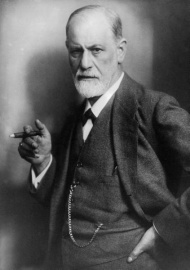Sigmund Freud
From Geography
Sigmund Freud (1856-1939) is the founding father of psychoanalysis. People could compare the basic principles of psychoanalysis with an icemountain: 90% is under water, 10% of the ice is above the water surface (Gammwell & Wells, 1989).
Different aspects from the psychoanalysis:
- Ambivalent towards parents
- Trained in hypnosis
- Emphasizing the role of sexuality
- Emphasizing the role of unconscious
Freud used hypnosis to assist patients in remembering surpressed traumatic memories. He also supposed that unconscious feelings and thoughts were at play since patients consciously wanted to change.
However, because Freud found that not all patients could be hypnotized, he developed an additional technique.This became the "Freie Aussage", if you saw everthing that comes to your mind eventualy your deep rooted desires, wishes and fantasies from within your subcoinscious will show themselves.
Accourding to Freud the human mind consist of three parts: The "es", the "uber-ich" and the "ich". Each of these parts have there own function in the human mind (Dream moods, n.d.).
Understanding the spatial relationships within the mind might help say something more about symptoms, like dreams. Freud is in this concept an equal thinker as Said. Said and his Orienentalism suggest the imaginative world of the East.
One example of Freuds imaginative thinking is for example the phenomenon of decolonization, which cannot be seen as the phenomenon itself but as a physical phenomenon in space (Elliot, 2000).
Freud also talks about the spatial model of the mind. In his opinion physical and mental systems cannot be described in spatial terms, a discription will be fictious and crude (Jones, 1953).
Dreams are also an important part in understanding the human mind. According to him our subcoinscois show itself through our dreams. Although not directly but via a symbological way. But in the end all of our dreams are about our sexual instincts. The art of unveiling our dreams is called: "Traumdeutung" (Dream moods, n.d.).
Example
An example why the thinking of Sigmund Freud is highly relevant to geography, is the way that many geographers have used this thinking to re-theorize the relationship between subjectivity and spatiality. Steve Pile (1996) combinated the work of Freud with the work of Henri Lefebvre to think through the relationship of the body and the city. Another researcher, Stuart Atiken (2001), has used the ideas of Sigmund Freud to analyse the contested spaces of childhood (Hubbard et al., 2004). By exploring the ways in which children construct and contest the meanings they attach to the material and social environments they inhabit after school and during the school holidays, he aims to show how the notion of `place' is bound up with the action and behaviour of the children who inhabit these significant spaces of childhood. Another example from the engagement of geography with psychoanalysis has been pronounced in feminist geography (Hubbard et al., 2004).
References:
Dream moods. (n.d.) Sigmund Freud. Found 14 september 2011, at http://www.dreammoods.com/dreaminformation/dreamtheory/freud.htm
Elliot, A. (1998). Freud in 2000. New York: Routledge
Gamwell, L & Wells, R. (1989): Sigmund Freud and Art. His Personal Collection of Antiquities. Binghamton: State University of New York
Hubbard, P., Kitchin, R., Valentine, G. (2004). Key thinkers on Space and Place. London: SAGE Publications Ltd
Jones, E. (1953) The Life and Work of Sigmund Freud. New York: basic books
Contributors
Published by Bas Boselie (s0813141) and Chriss van Pul (s0801364)
Edited by --JornJoosten 16:43, 14 September 2011 (UTC) & Loek Freulich s3004295
Page edited with a geographical example by Rens Mennen --RensMennen 13:40, 24 October 2012 (CEST)
Picture added by Doris Roelvink, October 25th 2012.
